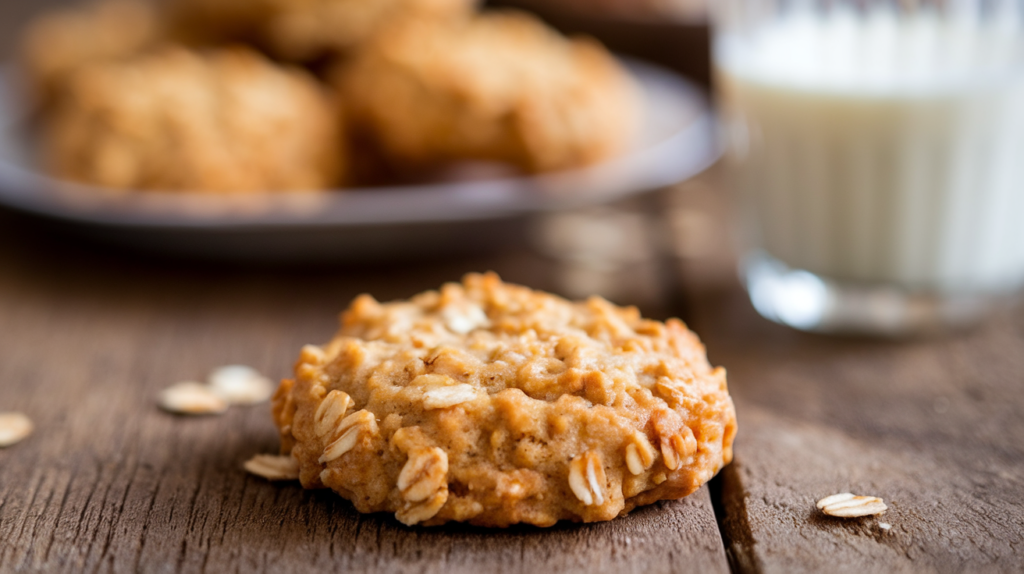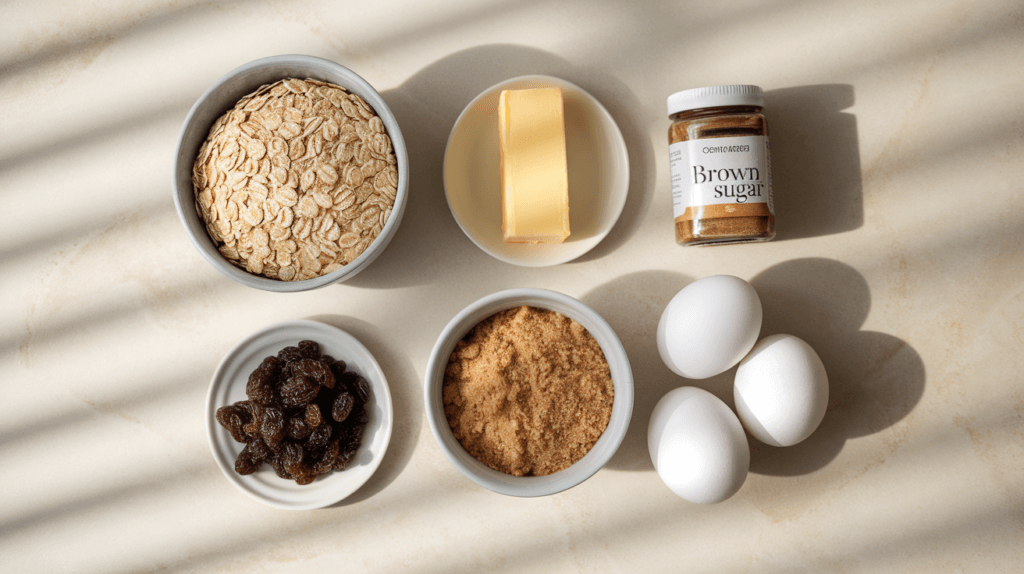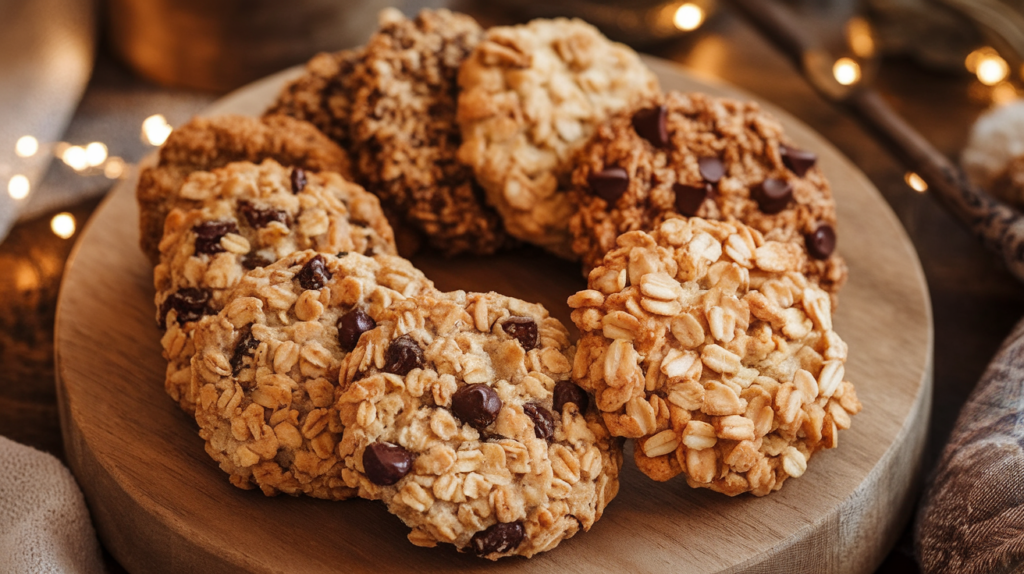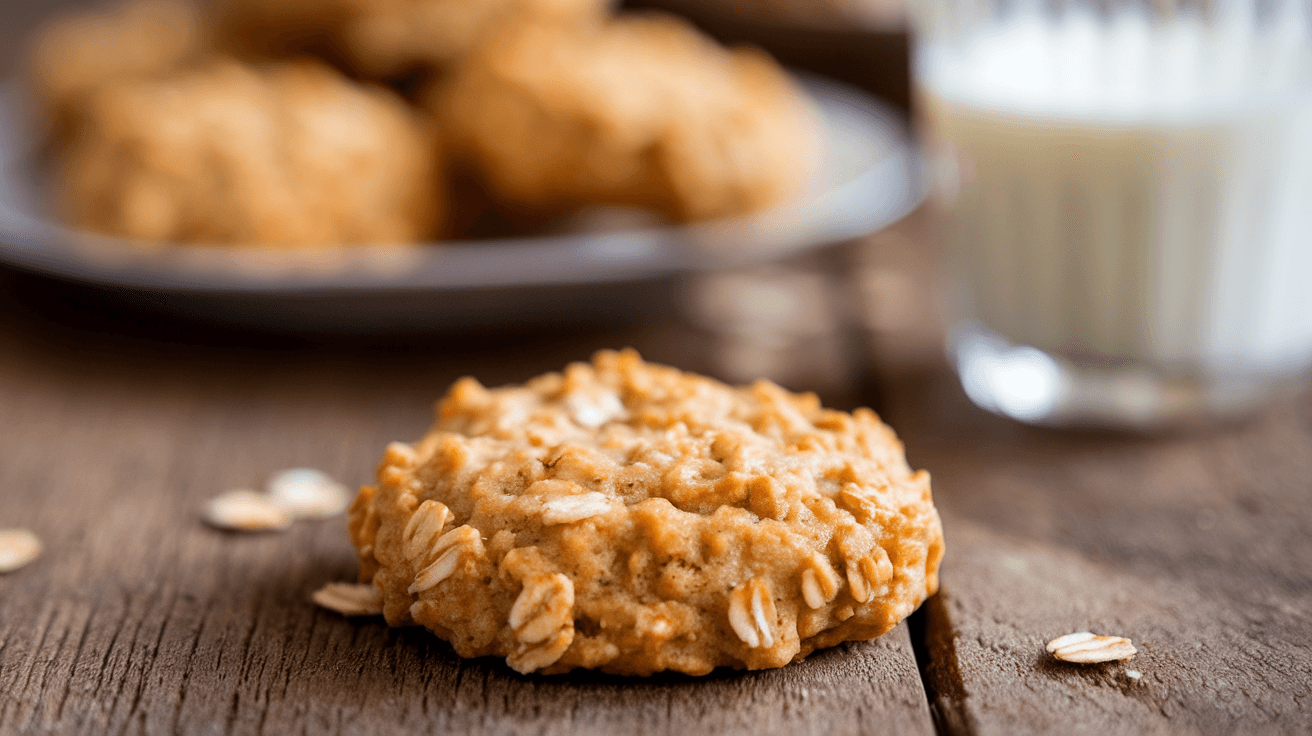Introduction

Oatmeal cookies are a classic treat loved for their chewy texture, hearty flavor, and wholesome ingredients. These cookies strike the perfect balance between sweetness and nutrition, making them a popular choice for snacks and desserts. But what exactly goes into an oatmeal cookie? In this article, we’ll break down the essential ingredients that form the backbone of this beloved cookie and explore the variations that make it a versatile favorite for bakers around the world.
Key Ingredients in an Oatmeal Cookie

Bakers combine staple baking ingredients with flavorful additions to create the signature taste and texture of oatmeal cookies. Below is a detailed look at the key components:
Oats
Oats define oatmeal cookies, providing the hearty texture and nutty flavor that set them apart from other cookie types. Bakers typically use rolled oats or quick oats, with each offering a slightly different texture. Additionally, oats pack a lot of dietary fiber, making them a nutritious base for these cookies.
What Does an Oatmeal Cookie Contain?
Oatmeal cookies delight people with their chewy texture, hearty flavor, and wholesome ingredients. These cookies perfectly balance sweetness and nutrition, making them a popular choice for snacks and desserts. But what exactly goes into an oatmeal cookie? In this article, we’ll explain the essential ingredients that create the backbone of this beloved cookie and explore the variations that make it a versatile favorite among bakers around the world.
Key Ingredients in an Oatmeal Cookie
Bakers combine staple baking ingredients with flavorful additions to create the signature taste and texture of oatmeal cookies. Below is a detailed look at the key components:
Oats
Oats are the defining ingredient in oatmeal cookies, providing the hearty texture and nutty flavor that sets them apart from other cookie types. Typically, rolled oats or quick oats are used, each offering a slightly different texture. Oats are also packed with dietary fiber, making them a nutritious base for these cookies.
Flour
Flour acts as the structural backbone of oatmeal cookies. While all-purpose flour is commonly used, some recipes incorporate whole wheat flour for added nutrition or alternative flours for specific dietary needs, such as gluten-free options.
Sweeteners
Sweeteners like brown sugar, granulated sugar, honey, or molasses contribute to the flavor and texture of oatmeal cookies. Brown sugar is a popular choice because it enhances the cookies’ moistness and adds a subtle caramel flavor.
Fats
Fats such as butter or vegetable oil play a critical role in determining the texture of oatmeal cookies. Butter is the most commonly used fat, offering a rich flavor and tender texture, while oil can be used for softer cookies.
Eggs
Eggs serve as a binding agent in oatmeal cookies, helping to hold the ingredients together. They also contribute to the structure and moistness of the final product, ensuring that the cookies don’t crumble apart.
Leavening Agents
Leavening agents such as baking soda or baking powder are essential for giving oatmeal cookies their lift and soft texture. They help the cookies spread and rise slightly during baking, creating the perfect chewy consistency.
Flavor Enhancers
Flavor enhancers like cinnamon, nutmeg, and vanilla extract add depth to the taste of oatmeal cookies. These small additions elevate the cookies from ordinary to extraordinary, making them more aromatic and flavorful.
Add-ins
Oatmeal cookies are highly customizable with add-ins such as raisins, chocolate chips, nuts, dried fruits, or seeds. These extras not only add bursts of flavor but also bring additional textures and nutritional benefits.
Nutritional Value of Oatmeal Cookies
Oatmeal cookies are often considered a healthier alternative to traditional cookies due to their wholesome ingredients. While they are a treat, they can provide some nutritional benefits when prepared with the right ingredients. Below is a breakdown of the key nutritional aspects of oatmeal cookies:
Calories
The calorie content of oatmeal cookies depends on the ingredients used. A standard oatmeal cookie made with butter and sugar typically contains between 100-150 calories per piece. Using healthier substitutes like honey or applesauce can reduce the calorie count, making them a better option for those watching their intake.
Dietary Fiber
Thanks to the oats, oatmeal cookies are a good source of dietary fiber. Fiber aids digestion, helps maintain healthy cholesterol levels, and provides a feeling of fullness. A single cookie can provide approximately 1-2 grams of fiber, depending on the recipe.
Protein
Eggs, oats, and certain add-ins like nuts or seeds contribute to the protein content of oatmeal cookies. On average, an oatmeal cookie contains 2-3 grams of protein, making it a more balanced snack compared to other cookie varieties.
Fats
Oatmeal cookies contain fats primarily from butter, oils, or add-ins like nuts. While they can be high in saturated fat when made with butter, switching to plant-based oils or nut butters can increase the proportion of healthy fats.
Sugar Content
Traditional oatmeal cookies are made with sweeteners like brown sugar or molasses, which can increase the sugar content. A typical cookie contains 8-12 grams of sugar. Reducing the sugar or using alternatives like stevia or monk fruit sweetener can create a healthier version.
Vitamins and Minerals
Oats are rich in essential vitamins and minerals, including manganese, phosphorus, and magnesium. Add-ins like raisins or nuts further boost the vitamin and mineral content, offering small amounts of iron, potassium, and vitamin E.
Customizing for Health
For a healthier oatmeal cookie, you can make substitutions like using whole-grain or almond flour instead of refined flour, reducing sugar, and incorporating superfoods like chia seeds or flaxseeds. These tweaks can enhance the cookie’s nutritional profile while retaining its delicious flavor.
Variations of Oatmeal Cookies

Bakers worldwide create numerous variations of oatmeal cookies to suit different tastes and dietary needs, showcasing their incredible versatility. From gluten-free options to vegan recipes, here are some popular oatmeal cookie variations:
Gluten-Free Oatmeal Cookies
For those with gluten sensitivities or celiac disease, gluten-free oatmeal cookies are a delicious option. These cookies use certified gluten-free oats and substitute traditional wheat flour with almond flour, coconut flour, or a gluten-free all-purpose blend. The result is a chewy, satisfying cookie that’s safe for gluten-free diets.
Vegan Oatmeal Cookies
Vegan oatmeal cookies eliminate animal-based ingredients like butter and eggs. Instead, they rely on plant-based substitutes such as coconut oil, margarine, or applesauce for moisture and flaxseeds or chia seeds as egg replacers. These cookies maintain their classic texture and flavor while being entirely plant-based.
Low-Sugar Oatmeal Cookies
Health-conscious bakers can opt for low-sugar oatmeal cookies by using sugar alternatives like stevia, monk fruit sweetener, or erythritol. Natural sweeteners like honey or mashed bananas can also reduce sugar content while adding a hint of sweetness and flavor.
Oatmeal Chocolate Chip Cookies
Adding chocolate chips to oatmeal cookies elevates them to a rich and indulgent dessert. Semi-sweet or dark chocolate chips work best, complementing the nutty oats and providing a perfect balance of flavors. For a gourmet twist, bakers can use chunks of high-quality chocolate.
Oatmeal Raisin Cookies
Oatmeal raisin cookies are a timeless classic. The chewy raisins add a burst of sweetness that pairs beautifully with the hearty oats and warm spices like cinnamon. These cookies are often associated with nostalgia and comfort.
Oatmeal Nut Cookies
For added crunch and protein, oatmeal nut cookies include ingredients like walnuts, pecans, or almonds. These nuts not only enhance the texture but also contribute healthy fats and nutrients, making the cookies more nutritious.
Spiced Oatmeal Cookies
Spiced oatmeal cookies typically feature a blend of warming spices, such as cinnamon, nutmeg, ginger, and cloves. Moreover, these cookies are particularly popular during the fall and holiday seasons, as they offer a comforting aroma and a cozy flavor profile that perfectly complements the chilly weather.
No-Bake Oatmeal Cookies
No-bake oatmeal cookies are a quick and easy variation that requires no oven. These cookies typically combine oats, peanut butter, cocoa powder, and a sweetener, forming a delicious treat that sets at room temperature or in the refrigerator.
FAQs About Oatmeal Cookies
Oatmeal cookies are a favorite snack for many, but questions often arise about their preparation, ingredients, and nutritional benefits. Here are some frequently asked questions and their answers:
1. Are oatmeal cookies healthier than regular cookies?
Oatmeal cookies are often considered healthier than traditional cookies because they contain oats, which are rich in fiber and nutrients. However, the overall healthiness depends on the ingredients used. Substituting refined sugar with natural sweeteners and using whole-grain flour can make them even healthier.
2. What kind of oats should I use for oatmeal cookies?
Rolled oats and quick oats are the most commonly used types. Rolled oats provide a chewier texture, while quick oats create a softer cookie. Steel-cut oats are not recommended as they remain too hard even after baking.
3. How can I make oatmeal cookies softer?
To make softer oatmeal cookies, you can start by using more brown sugar instead of granulated sugar. Additionally, ensure you don’t overbake them, as this can cause the cookies to dry out. Furthermore, adding an extra egg yolk or using melted butter can also significantly enhance their softness.
4. Can I freeze oatmeal cookie dough?
Yes, oatmeal cookie dough freezes well. Scoop the dough into balls and place them on a baking sheet to freeze. Once solid, transfer them to an airtight container or freezer bag. Bake directly from frozen, adding 1-2 minutes to the baking time.
5. Are oatmeal cookies gluten-free?
Traditional oatmeal cookies are not gluten-free because they typically contain wheat flour. However, by using certified gluten-free oats and a gluten-free flour substitute, you can make them suitable for gluten-sensitive individuals.
6. What can I use as a substitute for eggs in oatmeal cookies?
Common egg substitutes for oatmeal cookies include flaxseed meal mixed with water (flax eggs), mashed bananas, applesauce, or yogurt. These alternatives work well as binding agents and add their own unique flavors.
7. How do I prevent oatmeal cookies from spreading too much?
To prevent excessive spreading, chill the dough for at least 30 minutes before baking. Ensure the butter isn’t overly softened, and use parchment paper or a silicone baking mat to maintain proper shape during baking.
Conclusion
Oatmeal cookies are a beloved treat that combine wholesome ingredients with delightful flavors and textures. Their versatility allows for countless variations, catering to different tastes and dietary preferences. Whether you prefer the classic oatmeal raisin cookie, a vegan option, or a low-sugar version, these cookies can be adapted to suit any occasion.
The key to a perfect oatmeal cookie lies in the balance of its ingredients. Oats form the nutritious base, while sweeteners, fats, and spices enhance the taste and texture. Add-ins like chocolate chips, nuts, or dried fruits bring even more variety to this classic dessert.
From their nutritional benefits to the endless creative possibilities they offer, oatmeal cookies remain a favorite for both novice and experienced bakers. Whether you’re indulging in a comforting snack or sharing a batch with friends and family, oatmeal cookies are sure to satisfy.
Now that you know what goes into an oatmeal cookie and the many ways to customize them, it’s time to roll up your sleeves and start baking! Experiment with different ingredients and find your perfect combination for the ultimate oatmeal cookie experience.

